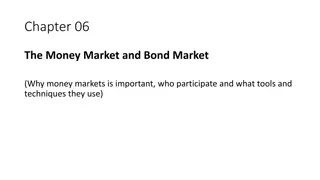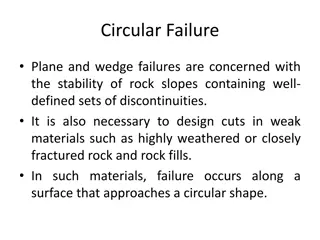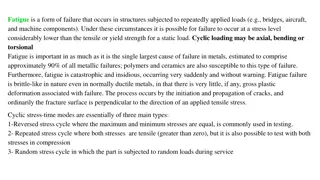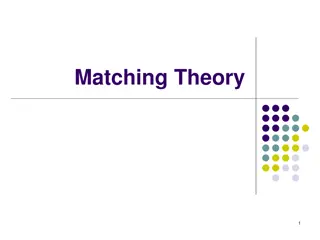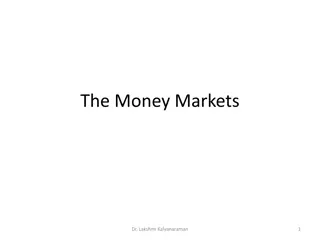Understanding the Theory of Coordination Failure in Markets
The theory of coordination failure explores how markets may struggle to achieve coordination among complementary activities, leading to suboptimal outcomes. It highlights scenarios where investors' actions depend on each other, emphasizing the role of government intervention to solve coordination issues. While big push strategies faced challenges, recent development economists have revisited the importance of complementarities for successful development. In an economy where actions of one entity affect others, coordination failures can result in undesirable equilibria, hindering optimal resource allocation.
Download Presentation

Please find below an Image/Link to download the presentation.
The content on the website is provided AS IS for your information and personal use only. It may not be sold, licensed, or shared on other websites without obtaining consent from the author. Download presentation by click this link. If you encounter any issues during the download, it is possible that the publisher has removed the file from their server.
E N D
Presentation Transcript
2. Theory of Coordination Failure: The foundation of the theory of coordination failure is the idea that the market may fail to achieve coordination among complementary activities. When complementarians exist, that is when returns of one investment depend on the presence or extent of other investments, there exist two scenarios. On the one hand, optimally, all investors as a whole are better off with all investments to be achieved at the same time. On the other hand, it would not make sense for an investor to take similar actions when he believes that others may not do the same as well.
The market is said to have failed to coordinate investors actions in this way. Coordination failure therefore leads the market to an (equilibrium) outcome inferior to a potential situation in which resources would be optimally allocated and all agents would be better off. As a result, underdevelopment equilibrium is possible
The theory of coordination failure became influential in the 1990s. However, it has a history of more than half a century. Coordination issues among complementary industries were first raised by Rosenstein-Rodan (1943). Like Rosenstein- Rodan (1943), early coordination failures economists Nurkse (1953) and Hirschman (1957) emphasized the role of the government to solve the problem. In order to reach an optimal level of coordination, the policy they recommended was a big push a public-led massive investment program which can cause complementarities to take place in the rest of the economy.
Like other early development models, big push strategies ran out of favour when the world witnessed the collapse of centrally planned economies and the slow growth, stagnation or worst results of state-led industrialization in the underdeveloped countries (Meier 2000). However, development economists have recently returned to emphasize the problem of complementarities between several conditions necessary for successful development to take place (Gl van 2008). Hoff (2000),and Bowles Durlauf and Hoff (2006) described the economy as an ecosystem where the behavior of one can affect the others . The coordination failure among many different individuals lead the economy to multiple equilibria, but not all of them are good for every member of the economy, and some in fact are very undesirable.
As a result, the market fails to coordinate everyone to achieve the optimal equilibrium. In other words, A firm s productivity depends not only on its own efforts, and abilities, and on general economic conditions (for example, the macroeconomic environment and the legal system), but also on the actions of other firms, infrastructure, regulation and other public goods
In a similar vein, Rodrik (2004) also indicated that success or failure of an action could depend on its milieu. In a market mechanism, there are uncertainties that a good equilibrium can be obtained. A bad equilibrium can exist when firms have pessimistic expectations and thus show their reluctance to invest, and consequently fail to coordinate their businesses. And whereas in the past we thought the implication was that the economy would be slightly distorted, we now understand that the interaction of these slightly distorted behaviours may produce very large distortions.
The consequence is that there may be multiple equilibria and that each may be inefficient (Hoff and Stiglitz 2000, p. 390). The existence of coordination failure can not therefore be disputed and has become important. When the market mechanism does not work, the active roles of the government need to be highlighted. According to coordination failure economists, in the multiple equilibria circumstances described above, the government can coordinate firms to move them into the domain of good equilibrium.
The theory of coordination failures offers some important overall lessons for policy-makers. The theory often highlights the problems of market failure that require selective government intervention to ensure that several things work well together at the same time. However, to get sustainable development underway is obviously not an easy task. The big push strategy is recommended recently by United Nations Development Programme (2005). The programme suggests that for developing countries to break out of the poverty trap, a big push of basic investments between now and 2015 in public administration, human capital and key infrastructure is necessary
However, the theory of coordination failure has been criticized for its overemphasis on the roles of government. Critics have asserted that the government is ineffective and could choose a bad policy (Killick 1976; Hoff and Stiglitz 2000). If a bad policy is implemented, it can push an economy into a bad equilibrium for years to come and even into a worse equilibrium than the one with which the country began (Hoff and Stiglitz 2000). Moreover, the policies recommended by coordination failure models lacked details of how the government can coordinate the economy. Policy-makers therefore need to be more cautious of these strategies to address coordination failure issues.
4 .Summary: The economic development is a multidimensional process that involves interactions among different goals of development and therefore would require systematically designed policies and strategies. Development issues are complex and multifaceted. There is no one single pathway for economic development that all countries can pursue. In the long term, the economic development process requires changes in policies to account for new emerging factors and trends. Designing these economic development policies also need to take into consideration the social, cultural, political systems and institutions as well as their changing interaction over time in a country.
Development strategies have changed remarkably over the past half century. Classical development economists often see underdevelopment as having a single cause. But history has demonstrated that focusing on one single factor alone cannot guarantee success in the development process. Capital formation (as emphasized in the linear stage growth models) is necessary but not sufficient. Structural change models that promoted industry but neglected agriculture also did not bring about the expected results.
The international dependence models pursued an inward-looking model of development that promoted state-run production. On the contrary, the neoclassical free market counter-revolution is a different strand of thought that supported the role of the free market, privatization and export expansion. However, the contemporary models of development see the government and the market as complements, in which a certain extent of government intervention is required to ensure that desirable outcomes can be achieved in the presence of related market failures
Although the ultimate goal of economic development goes beyond the growth of gross income (GDP, GNP or GNI) per capita, an understanding of the sources of growth is essential to achieve other objectives. Economic development is about growth plus organizational change (Hoff and Stiglitz 2000). Without growth, the change is unlikely to occur, since a country needs resources to realize other long term objectives. Growth and change will thus continue to be central to any development strategy. The critical knowledge in finding the source of growth has been closely related to capital formation. However, as reviewed previously, the major weakness of the early theories is that they focused on finding the constraints in capital formation of one factor, such as physical capital or human capital, that limit economic growth
Hence, their solution is simply to increase investments in the factor identified. History has shown that the solution to a single cause does not always guarantee successful economic development. The solution is not simply an increase in that capital. More importantly, the focus should be on how to use the capital in an economy that consists of a combination of interrelated production processes. As recently realized by the contemporary development economists, especially by the theorists of coordination failures, the solution to obtain sustainable development underway is to make sure that several things work well simultaneously. Economic development is a complex process which involves causal relationships. One cannot risk overlooking these relationships as they lie at the Centre of the development process. The theory of coordination failure thus served as a theoretical basis for connecting growth, trade and infrastructure construction later in this study.







